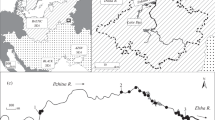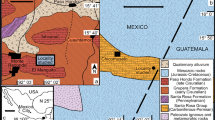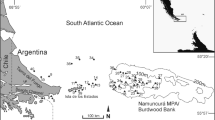Abstract
In the Mediterranean Sea, the brachiopod Gryphus vitreus (Born) was collected off Corsica by dredging and trawling during three cruises (June 1983; April and July 1984) and from along the French continental coast by dredging during many cruises (1975–1985). The upper limit of its bathymetric distribution lies between 115 and 125 m (rarely, from 90 m), the lower limit between 140 and 200 m depth, forming a belt along the edge of the continental shelf. The horizontal distribution of G. vitreus varies from ∼250 m to >4 km, and is directly related to geomorphological and hydrodynamic variations resulting from local topography and/or geographical location. The G. vitreus bottoms are bounded on the continental slope by the bathyal mud biocoenosis and on the shelf by the coastal detritic or shelf-edge detritic biocoenosis, both circalittoral. The bottoms correspond to a bathylittoral ecosystem characterized by (1) prevailing environmental conditions which result in a biotope characterized by coarse detritic sediment clogged by fine sand and mud with a high content of small hard substrates, by constant moderate bottom-currents which become weaker with increasing depth, and by small annual variations in temperature and salinity; the occurrence of an ostreobium sp. alga in the shell of G. vitreus indicates the involvement of the phytal system, as defined by Pérès (1982); (2) the G. vitreus biocoenosis, comprised of characteristic macrobenthic stocks (particularly polychaetes, mollusks, and epifaunal species on small hard substrates). Whatever the geomorphology, neighbouring circalittoral and bathyal biocoenoses have little influence on the G. vitreus biocoenosis, which displays a comparatively greater species richness and density. However, immigration of circalittoral species is encouraged by detrital sediments and water currents. The occurrence of this ecosystem as a distinct belt intercalated between circalittoral and bathyal zones is discussed. The ecosystem is considered to be “bathylittoral”.
Similar content being viewed by others
Littérature citée
Carpine, C.: Ecologie de l'étage bathyal dans la Méditerranée occidentale. Mém. Inst. océanogr. Monaco 2, 1–145 (1970)
Di Geronimo, I., C. Falconetti et G. Fredj: Quelques aspects et problémes posés par la faune malacologique des fonds à Gryphus vitreus (Born). Rapp. P.-v. Réun. Commn int. Mer Méditerr. 24, 137–139 (1977)
Emig, C. C.: Relations entre l'espèce, structure dissipatrice biologique, et l'écosystème, structure dissipatrice écologique. Contribution à la théorie de l'évolution des systèmes non-en équilibre. C. r. hebd. Séanc. Acad. Sci., Paris (Sér. 3) 300, 323–326 (1985)
Ergegovic, A.: Principes et essai d'un classement des étages benthiques. Recl Trav. Stn mar. Endoume 22 (13), 17–21 (1957)
Falconetti, C.: Bionomie benthique des fonds situés à la limite du plateau continental du Banc du Magaud (Iles d'Hyères) et de la région de Calvi (Corse), 287 pp. Thèse d'Etat, Université de Nice 1980
Fredj, G. et C. Falconetti: Sur la présence d'Algues filamenteuses perforantes dans le test des Gryphus vitreus (Born) (Brachiopodes, Térébratulidés) de la limite inférieure du plateau continental méditerranéen. C. r. hebd. Séanc. Acad. Sci., Paris 284, 1167–1170 (1977)
Gautier, Y. et J. Picard: Bionomie du banc du Magaud (Est des Iles d'Hyères). Recl Trav. Stn. mar. Endoume 21, (12), 28–40 (1957)
Giermann, G.: Morphologie et tectonique du plateau contiental entre le Cap Cavallo et Saint-Florent (Corse). Bull. Inst. océanogr. Monaco 69, 1–6 (1969)
Hondt, J. L. d': Bryozoaires épibiontes sur le brachiopodes articulé Gryphus vitreus (Born, 1778) en mer Méditerranée occidentale (Corse). Vie Milieu 34, 27–33 (1984)
Laborel, J., J. M. Pérès, J. Picard et J. Vacelet: Etude directe des fonds des parages de Marseille de 30 à 300 m avec la soucoupe plongeante Cousteau. Bull. Inst. océanogr. Monaco 58, 1–16 (1961)
Lumare, F.: Osservazioni sulle zoocoenosi caratteristiche dei fondi da pesca a strascico dall'archipelaga Toscano a La Spezia. Progmma Ric. Risor. mar. Fondo mar. 25 B, 5–29 (1968)
Pérès, J. M.: Le problème de l'étagement des formations benthiques. Recl Trav. Stn mar. Endoume 21, (12), 4–21 (1957)
Pérès, J. M.: Résultats scientifiques des campagnes de la “Calypso”. Contribution à l'étude des peuplements benthique du Golfe ibéro-marocain. Annls Inst. océanogr., Paris (N.S.) 41, 3–30 (1964)
Pérès, J. M.: Major benthic assemblages. In: Marine ecology, Vol. 5. Part I. pp 373–522. Ed. by O. Kinne. New York: J. Wiley & Sons 1982
Pérès, J. M. et J. Picard: Manuel de bionomie benthique de la Mer Méditerranée. Recl Trav. Stn mar. Endoume 23, (14), 5–122 (1958)
Pérès, J. M. et J. Picard: Nouveau manuel de bionomie benthique de la mer Méditerranée. Recl Trav. Stn mar. Endoume 47, (31), 1–137 (1964)
Picard, J.: Recherches qualitatives sur les biocoenoses marines de substrats meubles dragables de la région marseillaise. Recl Trav. Stn. mar. Endoume 52 (36), 1–160 (1965)
Picard, J.: Réflexions sur les écosystèmes marins benthiques: hiérarchisation, dynamique spatio-temporelle. Téthys 11, 230–242 (1985)
Reyss, D.: Les canyons sous-marins de la mer catalane, le rech du Cap et le rech Lacaze-Duthiers. 4. Etude synécologique des peuplements de macrofaune benthique. Vie Milieu 23 (1 B), 101–142 (1973)
Vaissière, R. et C. Carpine: Contribution à l'étude bionomique de la Méditerranée occidentale (Côte du Var et des Alpes Maritimes — côte occidentale de Corse). Compte-rendu des plongées en soucoupe plongenate SP 300. Bull. Inst. océanogr. Monaco 63, 1–36, (1964)
Vaissière, R. et G. Fredj: Contribution à l'étude bionomique de la Méditerranée occidentale (Côte du Var et des Alpes Maritimes — côte occidentale de Corse). Etude photographique préliminaire de l'étage bathyal dans la région de Saint-Tropez. Bull. Inst. océanogr. Monaco 64, 1–70 (1964)
Zenkevitch, L. A.: Biology of the seas of the U.S.S.R., [transl. from Russian by S. Botcharskaya]. 995 pp. London: Allen & Unwin 1963
Author information
Authors and Affiliations
Additional information
Communicated by J. M. Pérès, Marseille
Rights and permissions
About this article
Cite this article
Emig, C.C. Distribution et synécologie des fonds à Gryphus vitreus (Brachiopoda) en Corse. Marine Biology 90, 139–146 (1985). https://doi.org/10.1007/BF00428225
Accepted:
Issue Date:
DOI: https://doi.org/10.1007/BF00428225




